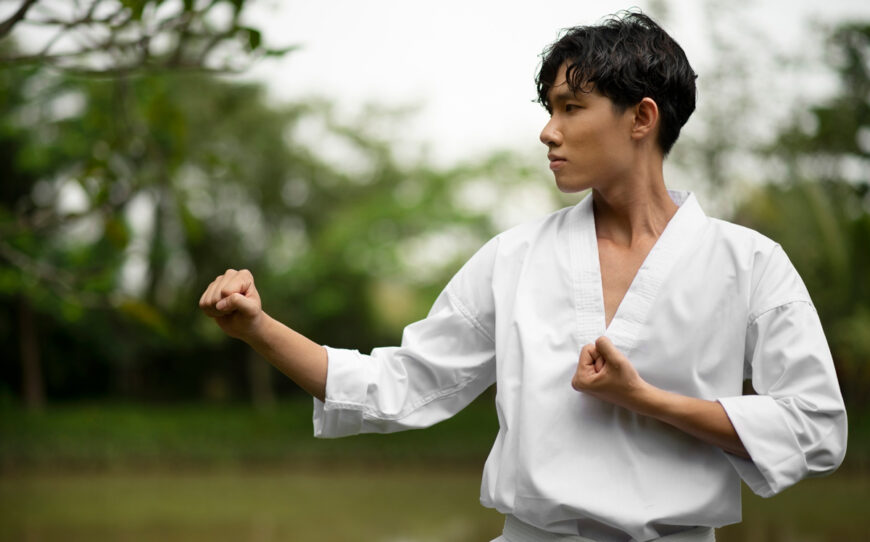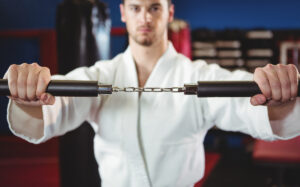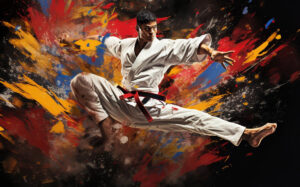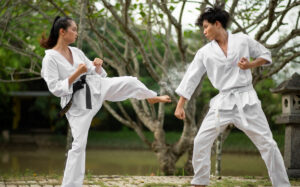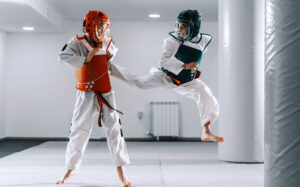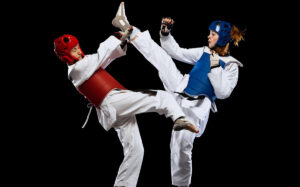Mastering the art of Taekwondo involves developing strong physical and mental discipline, along with learning essential techniques to excel in this martial art.
One fundamental aspect that both beginners and advanced practitioners need to work on is understanding and perfecting various stances. These basic Taekwondo stances serve as a foundation for performing powerful kicks, defensive moves, and balance during sparring sessions or competitions.
In this blog post, we will delve into the importance of proper Taekwondo stances and explore some common beginner and advanced positions used in training drills.
Key Takeaways
- Proper Taekwondo stances are crucial for improving balance, stability, strength, speed, and power while reducing the risk of injuries.
- Some fundamental Taekwondo stances include attention stance, at ease stance, inward stance, ready stance, horse riding stance, and walking stance; advanced practitioners also use the L stance and twist stance.
- Regular practice of these stances with good posture under a reputable instructor’s guidance can improve footwork skills significantly. It enhances performance in the forms of poomsae or sparring while instilling discipline and focus essential for learning martial arts techniques like Taekwondo.
- Mastering basic Taekwondo stances encourages personal accomplishment that encourages continued effort toward improvement.
The Importance of Proper Taekwondo Stances
Proper Taekwondo stances are essential for enhancing balance, stability, and strength, boosting speed and power, reducing the risk of injuries, and developing discipline and focus.
Enhances Balance, Stability, And Strength
Developing proper Taekwondo stances is essential for enhancing balance, stability, and strength in practitioners. These foundational elements are crucial not only for executing impressive high-flying kicks but also providing control during sparring and self-defence situations.
Additionally, practising these basic stances helps build the muscle memory required for advanced techniques that may involve rapid changes in footwork and weight distribution.
This increased strength and stability will lead to improved overall performance by making it easier to transition between different moves with grace and precision.
Boosts Speed And Power
Mastering proper Taekwondo stances plays a crucial role in enhancing an individual’s speed and power during martial arts practice. With the right stance, practitioners can generate optimal force while executing kicks, punches, and other techniques.
For instance, consider the forward stance (Ap Seogi), which enables increased power behind front strikes. This is achieved by placing one foot in front of the other with both knees slightly bent to maintain stability.
When transitioning into a strike from this position, the back leg provides adequate propulsion for maximum force delivery on impact.
Reduces The Risk Of Injuries
Mastering proper Taekwondo stances is essential in minimizing the risk of injuries during training and sparring sessions. By maintaining correct form, balance, and posture throughout various movements, practitioners can avoid stressing their joints and muscles in harmful ways.
Additionally, consistent practice of basic to advanced Taekwondo stances helps develop muscle strength and flexibility needed for executing more complex techniques safely.
This acquired physical competence protects martial artists from common injuries such as sprains or strains during high-intensity workouts.
Develops Discipline And Focus
One of the most valuable aspects of practising Taekwondo stances is the development of discipline and focus. As you progress through the different stances, you will learn to control your body movements with precision and accuracy, which requires a great deal of concentration and mental clarity.
Through consistent practice, Taekwondo also instills discipline into every practitioner’s daily routine by requiring them to adhere to strict rules and protocols during training sessions.
This teaches students not only how to respect their instructors but also how to respect themselves and others around them.
Furthermore, as students gain proficiency in various stances and techniques over time, they develop a sense of personal accomplishment that encourages continued effort toward further improvement.
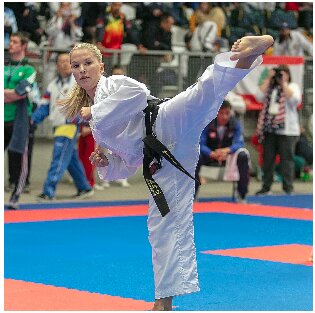
Fundamental Taekwondo Stances For Beginners
Learn the essential Taekwondo stances that will help improve your balance, stability, and strength.
Attention Stance (Charyeot Seogi)
The attention stance, also known as Charyeot Seogi, is the most fundamental and commonly used in Taekwondo. It is the first stance every beginner learns and it serves as a starting point for various techniques.
To do this stance correctly, stand with your feet shoulder-width apart and both knees slightly bent. Your arms should be extended along your sides with your fists clenched, and elbows tucked close to your body.
Proper form in attention stance will set you up for success in other stances such as ready stance (Joon-bee Seogi) or walking stance (Gunnun Sogi).
At Ease Stance (Pyeoni Seogi)
The At Ease Stance, or Pyeoni Seogi in Korean, is a relaxed position used frequently in Taekwondo. This stance is similar to the Attention Stance but allows for more relaxation and comfort.
In this stance, feet are shoulder-width apart with toes pointing slightly outward and knees unlocked. The arms can be held loosely at the sides or clasped together behind the back.
During training, instructors may call for students to shift into this stance between drills or exercises as a way of relaxing momentarily before moving on to the next task.
Additionally, when addressing an instructor, students will often assume this pose out of respect rather than holding themselves rigidly at attention.
Inward Stance (Anjjong Seogi)
The inward stance, also known as anjjong seogi, is a fundamental Taekwondo stance that builds the practitioner’s strength and balance. In this stance, both feet are facing forward with one foot placed slightly further back than the other.
The inward stance is commonly used in Taekwondo techniques such as punches, blocks, and strikes because it provides a solid base for these movements. Practicing this stance regularly can help enhance your core stability while improving your lower body strength and flexibility.
It’s important to maintain proper posture throughout this stance by keeping your head up, shoulders squared, and hips aligned.
Ready Stance (Joon-bee Seogi)
The ready stance, also known as Joon-bee Seogi, is a fundamental Taekwondo stance that transitions easily into other stances and movements. To get into the ready stance, stand with your feet shoulder-width apart and point your toes forward.
Then, bring one foot back slightly behind the other at an angle of about 45 degrees while keeping both knees bent.
In Taekwondo training, the ready stance is used frequently because it allows practitioners to switch positions rapidly and maintain balance in different situations. It’s also useful for executing various kicks and strikes more effectively since the practitioner has a stable base to work from.
Horse-Riding Stance (Kyorugi Seogi)
The horse-riding stance, also known as kyorugi seogi in Taekwondo, is a basic stance that requires the practitioner to have their feet wider than shoulder-width apart and both toes pointing forward.
This stance resembles sitting on a horse, hence its name. The knees are bent deeply in this stance to enhance stability and strength.
In addition to providing a stable base for attacking techniques, the horse-riding stance strengthens leg muscles and improves balance. Practicing this stance regularly can help martial arts practitioners develop strong legs while enhancing their overall physical fitness.
Walking Stance (Gunnun Sogi)
The walking stance, known as Gunnun Sogi in Taekwondo, is a basic stance that’s used for mobility and stability. In this stance, the practitioner steps forward or backward with one foot while keeping the other foot planted firmly on the ground.
To perform a proper walking stance, begin by standing with your feet shoulder-width apart. Step forward with one foot so that it’s roughly one-and-a-half times the length of your foot away from your back foot.
Keep your weight evenly distributed between both legs while bending slightly at the knees to maintain balance.
Walking stances are most commonly used during sparring drills when transitioning between different techniques quickly is crucial.
Forward Stance (Ap Seogi)
The forward stance, or ap seogi in Korean, is a basic Taekwondo stance that requires the practitioner to stand with one foot in front of the other and both feet pointing forward.
This stance is often used for sparring and attacking techniques such as punches and strikes.
To execute a proper forward stance, start by standing straight with your feet shoulder-width apart. Then, step one foot forward about two feet while keeping your back leg firmly planted on the ground at an angle of around 45 degrees.
Your front knee should be bent while your back leg remains straight. Whether you’re a beginner or an advanced practitioner, mastering basic stances like the forward stance can greatly improve your Taekwondo technique and form overall.
Advanced Taekwondo Stances
Advanced Taekwondo stances include the L stance, back stance, side stance, twist stance, cat stance, and fighting stance.
L Stance (Niunja Sogi)
The L stance, or niunja sogi, is a foundational fighting stance in Taekwondo. This powerful and versatile stance requires the practitioner to stand with one foot forward and one foot back at a perpendicular angle.
Practitioners use this stance for both defensive and offensive movements, as it allows for quick shifts in direction and swift changes between kicks and punches.
Its agility makes it easier for practitioners to dodge incoming attacks while maintaining balance and stability. The L stance also increases hip flexibility, making it ideal for roundhouse kicks that require full rotation of your hips.
Back Stance (Dwi Kubi)
The Back Stance, or Dwi Kubi in Korean, is a basic Taekwondo stance that is used for defense and counterattacks. In this stance, the practitioner stands with one foot behind the other and the majority of their weight on their back foot.
When moving forward from this stance, practitioners shift their weight onto their front foot as they step forward. This creates momentum for powerful kicks or strikes with the back leg.
Overall, mastering proper technique in using the Back Stance is crucial in developing a strong foundation in Taekwondo training.
Side Stance (Yop Sogi)
The side stance, or yop sogi in Korean, is a fundamental Taekwondo stance used to generate power and stability when executing certain techniques.
This stance requires the practitioner to have one foot facing forward while the other foot is turned 90 degrees to the side, with both feet shoulder-width apart.
This stance can be used in Taekwondo for various purposes such as delivering strikes like punches or low blocks. It’s also commonly used during sparring matches where fast lateral movements are needed to dodge an opponent’s attack.
Twist Stance (Bitureo Sogi)
The Twist Stance, also known as Bitureo Sogi in Korean, is an advanced Taekwondo stance requiring great balance and control. This stance involves pivoting on the ball of one foot while keeping the other foot stationary.
The practitioner should face forward with their hips while turning their upper body to either side.
To perform the Twist Stance effectively, having a strong core and good flexibility in your hips and lower back is crucial. It also takes practice to master the technique without losing balance or compromising posture.
Cat Stance (Beom Seogi)
The cat stance, also known as beom seogi in Korean, is a basic Taekwondo stance involving standing on one foot with the other tucked behind the knee.
This stance emphasizes balance and agility by forcing you to shift your weight onto one leg while keeping your body upright.
To perform the cat stance correctly, start from a ready position with both feet shoulder-width apart. Lift one foot off the ground and tuck it behind your supporting knee tightly.
Keep your arms up in front of you for balance and stability.
Practicing different stances like the cat stance regularly will enhance gracefulness and can bring focus to the technique during training sessions.
Fighting Stance (Gyoroogi Seogi)
The fighting stance (Gyoroogi Seogi) is crucial for sparring and competition in Taekwondo. It is designed to maximize your speed, balance, and power while providing ample protection against incoming attacks from your opponent.
In the fighting stance, you stand with one foot forward, knees slightly bent, and hands up in front of your face to protect your head and body.
To perfect your fighting stance in Taekwondo, it’s important to practice regularly with an experienced instructor who can guide proper technique and form. You should also strengthen your leg muscles through squats and lunges to improve stability during kicks or defensive movements.
Tips For Practicing Taekwondo Stances
Practice Taekwondo stances regularly and consistently to develop muscle memory, improve your form and posture, and build strength.
Practice Regularly And Consistently
To improve your Taekwondo stances, it’s important to practice regularly and consistently. Here are some tips to help you:
- Set a schedule for yourself and stick to it. Aim to practice at least a few times per week.
- Start with the basic stances and gradually work your way up to the more advanced ones.
- Take your time when practicing each stance. Focus on your form and posture, and make sure you’re holding the stance correctly.
- Practice each stance for longer periods as you progress. This will help improve your balance, stability, and strength.
- Incorporate stances into your training drills so that you can work on them in context with other techniques.
- Don’t be afraid to ask for feedback and guidance from your instructor or fellow practitioners. Use their input to improve your technique and form.
By practicing regularly and consistently, you’ll improve your Taekwondo stances and develop discipline, focus, and overall martial arts skills.
Work On Your Form And Posture
Proper form and posture are crucial in Taekwondo stances. Practicing good form helps to develop disciplined movement patterns, which will carry over to other aspects of your training.
When practicing Taekwondo stances, keep your back straight and your shoulders relaxed. Your feet should be planted firmly on the ground with a wide base for balance and stability.
It’s also essential to pay attention to the position of your head. Keep it up and straight, facing forward with eyes focused on the target ahead of you. This alignment will help you remain aware of your surroundings while maintaining a strong stance.
To improve posture further, try incorporating exercises that focus on core strength, such as planks or sit-ups, into your training routine.
Aim To Hold Each Stance For Longer Periods
It’s not enough to simply go through the motions of each Taekwondo stance. Practitioners need to hold each stance for longer periods to strengthen their muscles and improve balance, stability, and focus.
Holding a stance for just a few seconds won’t cut it; aim for at least 20-30 seconds per stance.
To make holding stances more challenging, incorporate movements such as punches, kicks, or shifting weight from one leg to another while maintaining the proper posture of each stance.
This will test your endurance and help build overall strength.
Incorporate Stances Into Your Training Drills
To fully master Taekwondo stances, it’s important to incorporate them into your regular training drills. This will help you build muscle memory and strengthen the specific muscles used for each stance, leading to better balance and stability in overall practice.
For instance, incorporating a horse-riding stance into kicking drills can improve your power and accuracy.
Combining a walking stance with hand techniques such as punches or blocks can enhance your speed and footwork coordination during sparring matches.
Seek Feedback And Guidance From Your Instructor
It is important to seek feedback and guidance from your Taekwondo instructor when practicing stances. Your instructor can help you improve your posture, form, and execution of each stance.
Remember that even advanced practitioners can benefit from the guidance of an experienced mentor. Seek out their advice and take note of their feedback during practice sessions.
FAQs
1. What are the basic taekwondo stances for beginners?
The basic taekwondo stances for beginners include the attention stance, front stance, back stance, and horse riding stance. These stances serve as a foundation for all other techniques in taekwondo.
2. How can I improve my balance in taekwondo stances?
To improve your balance in taekwondo stances, it is important to practice regularly and focus on proper posture. You can also incorporate single-leg balancing drills or yoga poses to help strengthen your core muscles.
3. Are there different types of advanced taekwondo stances?
Yes, advanced taekwondo practitioners may use more specialized stances. Such as the sliding step or tiger stance which require greater strength, flexibility, and control than the basic beginner-level stances.
4. Why is the correct Taekwondo Stance important?
Correct Taekwondo stances are crucial for balance, stability, and effective technique execution. They provide a strong foundation for power and agility, enabling better control and defense. Proper stances also help prevent injury by distributing weight evenly. In Taekwondo, where precision and speed are essential, mastering stances is fundamental for martial artists to perform at their best.
Conclusion
Mastering basic taekwondo stances is crucial for beginners and advanced practitioners alike to achieve balance, stability, strength, speed, and power and reduce the risk of injuries.
One can improve their footwork skills by practicing regularly with good posture and seeking guidance from a reputable instructor. This will enhance their overall performance in the forms of poomsae or sparring.
Learn More About Taekwondo
- Basic Taekwondo Forms To Master: Unlock Your Inner Warrior
- Taekwondo Vs Karate: The Ultimate Showdown
- Taekwondo Kicks: Learn Everything About The Kicks In Taekwondo
- Top 10 Greatest Taekwondo Players of All Time
- Best Martial Arts for Streetfight: Unleash Your Inner Warrior
- Best Taekwondo Schools in the World
- Top 21 Deadliest Martial Arts in the World According to Experts
- Taekwondo Belt Levels and Ranking Guide
- Taekwondo Weapons

